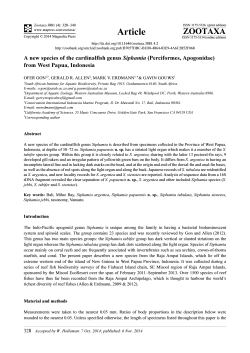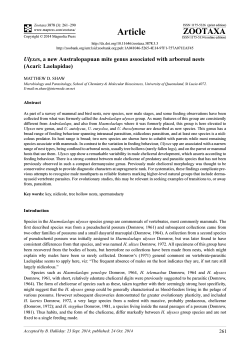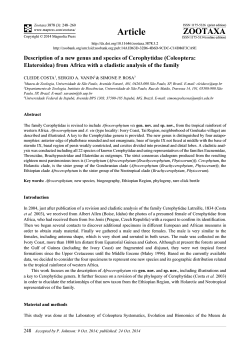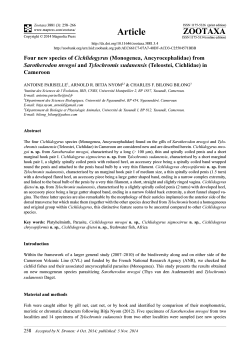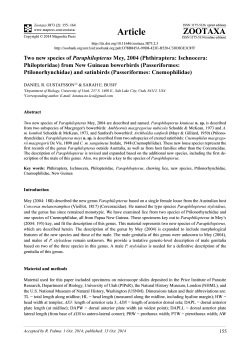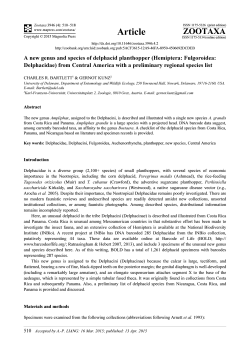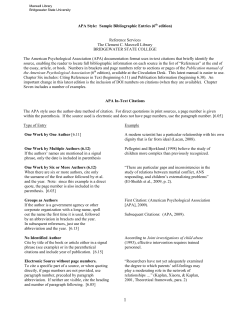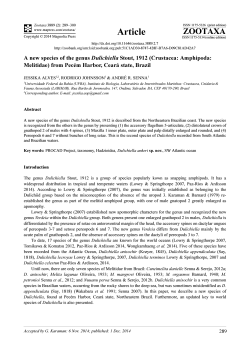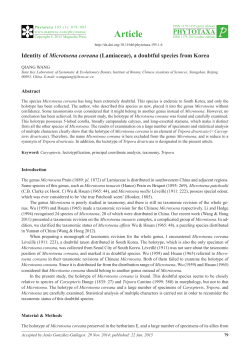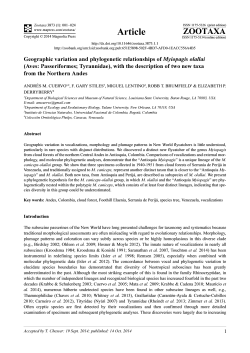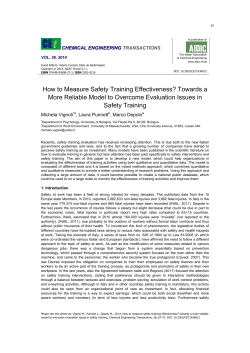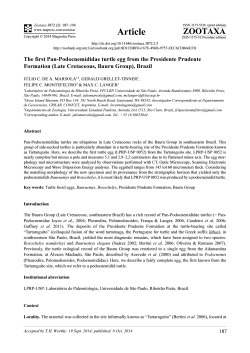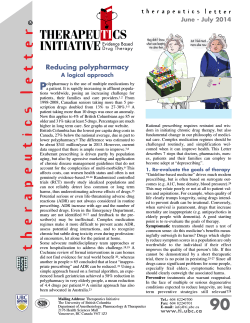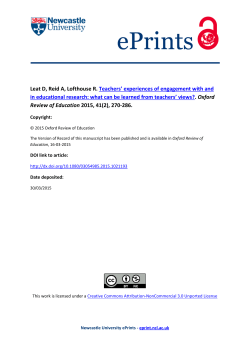
Article ZOOTAXA
Zootaxa 3878 (1): 019–036 www.mapress.com /zootaxa / Copyright © 2014 Magnolia Press Article ISSN 1175-5326 (print edition) ZOOTAXA ISSN 1175-5334 (online edition) http://dx.doi.org/10.11646/zootaxa.3878.1.2 http://zoobank.org/urn:lsid:zoobank.org:pub:FDE7F7A4-7DCC-4155-8D96-A0539229DBFE A new species of Eumops (Chiroptera: Molossidae) from southwestern Peru CÉSAR E. MEDINA1, RENATO GREGORIN2, HORACIO ZEBALLOS1,3, HUGO T. ZAMORA1 & LIGIANE M. MORAS4 1 Museo de Historia Natural de la Universidad Nacional San Agustín (MUSA). Av. Alcides Carrión s/n. Arequipa, Perú. E-mail: cmedinap1234@yahoo.com 2 Departamento de Biologia, Universidade Federal de Lavras, Lavras, Minas Gerais, CEP 37200-000, Brazil. E-mail: rgregorin@dbi.ufla.br 3 Instituto de Ciencias de la Naturaleza, Territorio y Energías Renovables, Pontificia Universidad Católica del Perú, Av. Universitaria 1801, San Miguel, Lima 32, Perú. E-mail: horaciozeballos@gmail.com 4 Departamento de Zoologia, Universidade Federal de Minas Gerais, Belo Horizonte, Minas Gerais, Brazil. E-mail: ligimoras@yahoo.com.br Abstract The genus Eumops is the most diverse genera of molossid bats in the Neotropics. In Peru this genus is widely distributed and represented by nine species: E. auripendulus, E. delticus, E. hansae, E. maurus, E. nanus, E. patagonicus, E. perotis, E. trumbulli, and E. wilsoni. After several years of mammalian diversity surveys in the coastal desert and western slopes of southwestern Peru, a specimen of Eumops was collected whose unique set of traits allows us to assert that deserves to be described as a new species. Based on molecular and morphological evidence, the new species is related to mediumlarge sized species (i.e. E. glaucinus, E. auripendulus, and E. perotis). Cytochrome b genetic divergence between the new species and the other species of the genus was high (> 12%) and it is consistent with morphological divergence presented for this new species. This new species, endemic to Peru, increases the diversity of Eumops to 16 species. Key words: Bonneted bat, coastal desert, endemism, Molossidae, phylogeny, Peru Introduction The Neotropical genus Eumops Miller, 1906, belongs to the nearly cosmopolitan bat family Molossidae (Eger 2008). The combined geographic ranges of the species of the genus extend from southern United States to Patagonia in Argentina (Eger 1977). Eumops occurs in a great variety of habitats from sea level up to 3000 m (Eger 1977; Eisenberg & Redford 1999; Eger 2008). Currently Eumops includes 15 species: E. auripendulus (Shaw, 1800); E. bonariensis (Peters, 1874); E. dabbenei Thomas, 1914; E. delticus Thomas, 1923; E. ferox (Gundlach, 1861); E. floridanus Allen, 1932; E. glaucinus (Wagner, 1843); E. hansae Sanborn, 1932; E. maurus (Thomas, 1901a); E. nanus (Miller, 1900); E. patagonicus Thomas, 1924; E. perotis (Schinz, 1821); E. trumbulli (Thomas, 1901b); E. underwoodi Goodwin, 1940; and E. wilsoni Baker et al., 2009. Since the description of Eumops in the early 1900’s (Miller 1906), two major revisions were focused on its taxonomy (Sanborn 1932; Eger 1977) and several studies analyzed relationships within the genus based on phenetic analyses of similarity (Eger 1977), biochemical approaches (Dolan & Honeycutt 1978), and cladistic analyses based on morphological and molecular data (Gregorin 2009; Bartlett et al. 2013). Nine species of Eumops occur in Peru (E. auripendulus, E. delticus, E. hansae, E. maurus, E. nanus, E. patagonicus, E. perotis, E. trumbulli, and E. wilsoni). They are widely distributed throughout the country, including northwestern dry forest, coastal desert, mountain forest, Amazonian forest and savannah portions (Eger 1977; Eger 2008; Baker et al. 2009; Pacheco et al. 2009; Díaz 2011; Medina et al. 2012). In 2010, after four years of assessing the mammalian diversity of the coastal desert and western slopes of southwestern Peru, a specimen of Eumops was collected in the Department of Moquegua whose unique set of traits warrants it recognition as a new species. Accepted by P. Velazco: 7 Oct. 2014; published: 22 Oct. 2014 19 Molossus molossus, Promops davisoni, Tadarida brasiliensis, Histiotus montanus, among others), nectarivorous (Platalina genovensium), and frugivorous species (Sturnira bogotensis), some of which are endemic and threatened (Tomopeas ravus, Amorphochilus schnablii, and P. genovensium) (Zeballos et al. 2001; Pacheco et al. 2009). Since November 2010, new expeditions have been carried out to El Algarrobal attempting to capture more individuals of E. chiribaya, without success. However, five individuals of Kalinowski's free tail bat (Mormopterus kalinowskii) were captured in the mouth of Osmore River (7.7 km E type locality of E. chiribaya). Despite nearly 2,000 net-hours with 100 individuals caught in almost a decade of fieldwork in southwestern Peru (Tacna, Moquegua, and Arequipa), not a single individual of E. chiribaya was captured. This rarity may be explained because mostly Neotropical molossids forage far above net range and, therefore, are underestimated in inventories that are based solely on mist-net capture (Jung et al. 2014) or by its natural rarity, reduced populations, and restricted distribution (Arita 1993). El Algarrobal is located in a narrow valley surrounded by steep hills (slope > 60°) and has notable human activity resulting from changes in land use, such as intensive agriculture of Olive trees (Olea europaea), urban expansion, mining activities and other anthropogenic factors. The sparse native vegetation is limited to river banks and the annual average temperature and precipitation are 18.3 °C and 74.4 mm, respectively (INRENA 1994). Furthermore the nearest Protected Area is 80 km NW of El Agarrobal (Lagunas de Mejia National Sanctuary). The continuous loss of habitat and restricted distribution of E. chiribaya warrants its placement under some category of protection, however with only one specimen it is impossible to assess population stability and so it must be considered Data Deficient until more long-term data is obtained (International Union for Conservation of Nature and Natural Resources 2011). Because of the threats facing this species we consider necessary the implementation of conservation actions (i.e., identified and protection of roosts, educate local people through workshops on insectivorous bats, and short courses on the importance of bats in the ecosystem). Acknowledgements We thank the curators of the museums we visited or who loaned us material, and for the use of their facilities to study specimens: Judith Chupasko (MCZ), Mario de Vivo (MZUSP), Judith Eger (ROM), Mark S. Hafner (LSU), Paulina Jenkins (BMNH), Emygdio Leite (ZUEC), Jessica E. Light (TCWC), Evaristo López (MUSA), Philip Myers (UMMZ), Víctor Pacheco (MUSM), Bruce D. Patterson (FMNH), James Patton (MVZ), Adriano L. Peracchi (ALP), Nancy B. Simmons (AMNH), Valdir Taddei (DZSJRP), and Don Wilson (USNM). We are especially grateful to Paúl M. Velazco who carefully read an earlier version of this manuscript and gave insightful comments for its improvement. Thanks to Don Wilson for the pertinent suggestions and improvements to the English. This study was partially supported by Fundação de Amparo à Pesquisa do Estado de Minas Gerais (FAPEMIG) and Conselho Nacional de Desenvolvimento Científico e Tecnológico (CNPq). References Akaike, H. (1974) A new look at the statistical model identification, IEEE Transactions on Automatic Control, 19 (6), 716–723. http://dx.doi.org/10.1109/TAC.1974.1100705 Allen, G.M. (1932) A Pleistocene bat from Florida. Journal of Mammalogy, 13, 256–259. Ammerman, L.K., Lee, D.N. & Tipps, T.M. (2012) First molecular phylogenetic insights into the evolution of tree-tailed bats in the subfamily Molossinae (Molossidae, Chiroptera). Journal of Mammalogy, 93, 12–28. http://dx.doi.org/10.1644/11-MAMM-A-103.1 Arita, H.T. (1993) Rarity in Neotropical bats: correlations with phylogeny, diet, and body mass. Ecological Applications, 3, 506–517. http://dx.doi.org/10.2307/1941919 Baker, R.J., McDonough, M.M., Swier, V.J., Larsen, P.A., Carrera, J.P. & Ammerman, L.K. (2009) New species of bonneted bat, genus Eumops (Chiroptera: Molossidae) from the lowlands of western Ecuador and Peru. Acta Chiropterologica, 11, 1–13. http://dx.doi.org/10.3161/150811009X465659 Bartlett, S.N., McDonough, M.M. & Ammerman, L.K. (2013) Molecular systematics of bonneted bats (Molossidae: Eumops) based on mitochondrial and nuclear DNA sequences. Journal of Mammalogy, 94, 867–880. http://dx.doi.org/10.1644/12-MAMM-A-134.1 NEW EUMOPS FROM PERU Zootaxa 3878 (1) © 2014 Magnolia Press · 31 Bernardi, I.P., Miranda, J.M.D. & Passos, F.C. (2009) Status taxonomico e distribucional do complexo Eumops bonariensis (Chiroptera: Molossidae) no sul do Brasil. Zoologia, 26, 183–190. http://dx.doi.org/10.1590/S1984-46702009000100025 Brown, M.T. & Wicker, L.R. (2000) Discriminant analysis. In: Tinsley, H.E.A. & Brown, S.D. (eds.), Handbook of applied multivariate statistics and mathematical modeling. Academic Press, San Diego, California, pp. 209–235. Díaz, M.M. (2011) New records of bats from the northern region of the Peruvian Amazon. Zoological Research, 32, 168–178. http://dx.doi.org/10.3724/SP.J.1141.2011.02168 Dolan, P.G. & Honeycutt, R.L. (1978) Systematics and evolutionary implications of genic variation in the mastiff bat, Eumops (Chiroptera: Molossidae). Bat Research News, 19, 1–72. Edgar, R.C. (2004) MUSCLE: multiple sequence alignment with high accuracy and high throughput. Nucleic Acids Research, 32, 1792–1797. http://dx.doi.org/10.1093/nar/gkh340 Eger, J.L. (1977) Systematics of the genus Eumops (Chiroptera: Molossidae). Life Sciences Contributions, Royal Ontario Museum, 110, 1–69. Eger, J.L. (2008) Family Molossidae. In: Gardner, A.L. (Ed.), Mammals of South America Vol 1: Marsupials, Xenarthrans, Shrews and Bats, 2nd edition. Smithsonian Institution Press, Washington, pp. 399–440. Eisenberg, J.F. & Redford, K.H. (1999) Mammals of the Neotropics, the central Neotropics, Vol. 3. Ecuador, Peru, Bolivia, Brazil. The University of Chicago Press, Chicago, 609 pp. Freeman, P.W. (1981) A multivariate study of the family Molossidae (Mammalia, Chiroptera): morphology, ecology, evolution. Fieldiana: Zoology, 7, 1–173. [New Series] Geoffroy St.-Hilaire, I. (1824) Mémoire sur une chauvesouris Américaine, formant une nouvelle espece dans le genre Nyctinome. Annales du Museum d'histoire naturelle, Paris, 1, 337–347. [1plate] Giannini, N.P., Wible, J.R. & Simmons, N.B. (2006) On the cranial osteology of Chiroptera. I. Pteropus (Megachiroptera: Pteropodidae). Bulletin of the American Museum of Natural History, 295, 1–134. http://dx.doi.org/10.1206/0003-0090(2006)295[0001:OTCOOC]2.0.CO;2 Giannini, N.P. & Simmons, N.B. (2007) The Chiropteran Premaxilla: A Reanalysis of Morphological Variation and Its Phylogenetic Interpretation. American Museum Novitates, 3585, 1–44. http://dx.doi.org/10.1206/0003-0082(2007)3585[1:TCPARO]2.0.CO;2 Gregorin, R. (2009) Phylogeny of Eumops Miller, 1906 (Chiroptera: Molossidae) using morphological data. Acta Chiropterologica, 11, 247–258. http://dx.doi.org/10.3161/150811009X485495 Goloboff, P., Farris, J. & Nixon, K. (2008) TNT, a free program for phylogenetic analysis. Cladistics, 24, 774–786. http://dx.doi.org/10.1111/j.1096-0031.2008.00217.x Goodwin, G.G. (1940) Three new bats from Honduras and the first record of Enchisthenes harti (Thomas) for North America. American Museum Novitates, 1075, 1–3. Gundlach, J. (1861) [Untitled.] Monatsberichte der Koniglichen Preussische Akademie des Wissenschaften zu Berlin, 1861, 149–156. Hammer, Ø. (2013) PAST: Paleontological statistics Version 3.0, Reference manual. 221 pp. Hand, S.J. (1990) First Tertiary Molossid (Microchiroptera: Molossidae) from Australia: its Phylogenetic and Biogeographic Implications. Memoirs of The Queensland Museum, 28, 175–192. Huelsenbeck, J.P. & Ronquist, F. (2001) MrBayes: Bayesian inference of phylogenetic trees. Bioinformatics, 17, 754–755. http://dx.doi.org/10.1093/bioinformatics/17.8.754 INRENA. (1994) Mapa Ecológico del Perú: Guía Explicativa. Ministerio de Agricultura. Lima – Peru. International Union for Conservation of Nature and Natural Resources (2011) Guidelines for using the IUCN red list categories and criteria. Version 9.0. Prepared by the Standards and Petitions Subcommittee. International Union for Conservation of Nature and Natural Resources, Gland, Switzerland. Jung, K., Molinari, J. & Kalko, E.K. (2014) Driving factors for the evolution of species-specific echolocation call design in New World free-tailed bats (Molossidae). PloS ONE, 9 (1), e85279. http://dx.doi.org/10.1371/journal.pone.0085279 Kimura, M. (1980) A simple method for estimating evolutionary rate of base substitutions through comparative studies of nucleotide sequences. Journal of Molecular Evolution, 16, 111–120. Kocher, T.D., Thomas, W.K., Meyer, A., Edwards, S.V.E., Pääbo, S., Villablanca, F.X. & Wilson, A.C. (1989) Dynamics of mitochondrial DNA evolution in animals: amplification and sequencing with conserved primers. Proceedings of the National Academy of Science, 86, 6196–6200. Medina, C.E., Zamora, H.T., Zeballos, H., Pari, A., Pino, K. & Delgado, W. (2012) Primer registro de Eumops patagonicus y ampliación del rango de distribución geográfica de E. hansae, en el sur de Perú. Mastozoología Neotropical, 19, 345–351. Miller, G.S.Jr. (1900) A new free-tailed bat from Central America. Annals Magazine of Natural History, 6, 471–72. [series 7] http://dx.doi.org/10.1080/00222930008678410 Miller, G.S.Jr. (1906) Twelve new genera of bats. Proceedings of Biological Society of Washington, 19, 83–87. Miller, M.A., Pfeiffer, W. & Schwartz, T. (2010) Creating the CIPRES Science Gateway for inference of large phylogenetic trees. Proceedings of the Gateway Computing Environments Workshop (GCE), New Orleans, LA, 8 pp. 32 · Zootaxa 3878 (1) © 2014 Magnolia Press MEDINA ET AL. http://dx.doi.org/10.1109/GCE.2010.5676129 Nylander, J.A.A. (2004) MrModeltest v2. Program distributed by the author. Evolutionary Biology Centre, Uppsala University. Pacheco, V., Cadenillas, R., Salas, E., Tello, C. & Zeballos, H. (2009) Diversidad y Endemismo de los Mamíferos del Perú. Revista Peruana de Biología, 16, 5–32. Pallas, P.S. (1766) Miscellanea Zoologica, quibus novae imprimis atque obscurae animalium species describuntur, et observationibus iconibusque illustrantur. Petrum van Cleef : The Hague, xii, 224 pp. [14 plates] Peters, W. (1874) Ü-ber eine neue Art von Flederthieren, Promops bonariensis und über Lophuromys, eine Nagergattung von Westafrika. Monatsberichte der Königlich preussischen Akademie der Wissenschaften zu Berlin, 1875, 232–234. Pumo, D.E., Finamore, P.S., Franek, W.R., Phillips, C.J., Tarzami, S. & Balzarano, D. (1998) Complete Mitochondrial Genome of a Neotropical Fruit Bat, Artibeus jamaicensis, and a New Hypothesis of the Relationships of Bats to Other Eutherian Mammals. Journal of Molecular Evolution, 47, 709–717. http://dx.doi.org/10.1007/PL00006430 Redondo, R.A.F., Brina, L.P.S., Silva, R.F., Ditchfield, A.D. & Santos, F.R. (2008) Molecular systematics of the genus Artibeus (Chiroptera: Phyllostomidae). Molecular Phylogenetics and Evolution, 49, 44–58. http://dx.doi.org/10.1016/j.ympev.2008.07.001 Sambrook, J., Russell, D.W. & Sambrook, J. (2001) Molecular Cloning: A Laboratory Manual, third edition. CSHL press, New York, USA, 2100 pp. Sanborn, C.C. (1932) The bats of the genus Eumops. Journal of Mammalogy, 13, 347–357. Schinz, H.R. (1821) Das Thierreich eingetheilt nach dem Bau der Thiere als Grundlage ihrer Naturgeschichte und der vergleichenden Anatomie von dem Herrn Ritter von Cuvier. Vol. 1. Erster band. Säugethiere und Vógel. Stuttgart und Tübingen: J. G. Cotta’schen Buchhandlung, xxxviii+894 pp. Shaw, G. (1800) General zoology or systematic natural history. Vol. 1. London: G. Kearsley, xv+552 pp. [121 plates] Siles, L., Daniel, M., Brooks, D.M., Aranibar, H., Tarifa, T., Vargas, R.J., Rojas, J.M. & Baker, R.J. (2013) A new species of Micronycteris (Chiroptera: Phyllostomidae) from Bolivia. Journal of Mammalogy, 94, 881–896. http://dx.doi.org/10.1644/12-MAMM-A-259.1 Stamatakis, A. (2006) RAxML-VI-HPC: maximum-likelihood based phylogenetic analyses with thousands of taxa and mixed model. Bioinformatics, 22, 2688–2690. http://dx.doi.org/10.1093/bioinformatics/btl446 Tamura, K., Peterson, D., Peterson, N., Stecher, G., Nei, M. & Kumar, S. (2011) MEGA5: Molecular evolutionary genetics analysis using maximum likelihood, evolutionary distance, and maximum parsimony methods. Molecular Biology and Evolution, 28, 2731–2739. http://dx.doi.org/10.1093/molbev/msr121 Thomas, O. (1901a) A new free-tailed bat from the lower Amazons. Annals Magazine of Natural History, 7, 190–191. [series 7] Thomas, O. (1901b) On a collection of mammals from the Kanuku Mountains, British Guiana. Annals Magazine of Natural History, 8, 139–154. [series 7] http://dx.doi.org/10.1080/03745480109442900 Thomas, O. (1914) New Callicebus and Eumops from S. America. Annals Magazine of Natural History, 13, 480–481. [series 8] http://dx.doi.org/10.1080/00222931408693514 Thomas, O. (1923) Two new mammals from Marajó Island. Annals Magazine of Natural History, 12, 341–342. [series 9] http://dx.doi.org/10.1080/00222932308632954 Thomas, O. (1924) New South American small mammals. Annals Magazine of Natural History, 13, 234–237. [series 9] http://dx.doi.org/10.1080/00222932408633035 Wagner, J.A. (1843) Diagnosen neuer Arten brasilischer Handflügler. Archiv fur Naturgeschichte, 9, 365–368. Zeballos, H., Pacheco, V. & Baraybar, E. (2001) Diversidad y conservación de los mamíferos de Arequipa, Perú. Revista Peruana de Biología, 8, 94–104. APPENDIX I The following list includes all specimens examined in this study, with their respective localities. Specimens used in the morphometric analysis are indicated with asterisk (*). Eumops auripendulus (92)—BOLIVIA: Beni, Rurrenabaque: AMNH 248209*, 248211–13*, 248215*, 248220*, 248221, 248222*, 248223–24, 248225*, 248226, 248227*, 248228, 248229*, 248230. BRAZIL: Acre, Plácido de Castro: MZUSP 7281–87, 7290–93*, 7297*, 7302*; MACN 16574*; Tarauacá: MZUSP 8245*; Faro, Rio Amazonas: AMNH 93852*, 93855–56*; Amazonas, Humaita: DZSJRP 13357*, 13358*, 14194*; Iroçanga, Tapajós: FMNH 140794*. COLOMBIA: Meta, Villavicencio: AMNH 149256*, 183321*, ROM 45530*; Guaicarama: AMNH 74359*, MCZ 27862*; Norosí: USNM 281251*, 281252*. ECUADOR: Manabi, Rio Mongoya: FMNH 53511–13. GUYANA: Barima-Waini, Arakaka: AMNH 207327*, 207329–30*, 207332*, 207334*, 207336–37*, 207340*. FRENCH GUIANA: Cayenne, Sinnamary, Paracou: AMNH 267537*. PANAMA: Boca del Toro, Changuinola: USNM 315787–88*; Bohio, Canal Zone: USNM 178207–09*; Boim: MZUSP 5659–60*; Fort Kobbe, Canal Zone: USNM 317628*, 312120*; Gamboa, Canal Zone: MVZ NEW EUMOPS FROM PERU Zootaxa 3878 (1) © 2014 Magnolia Press · 33
© Copyright 2025



